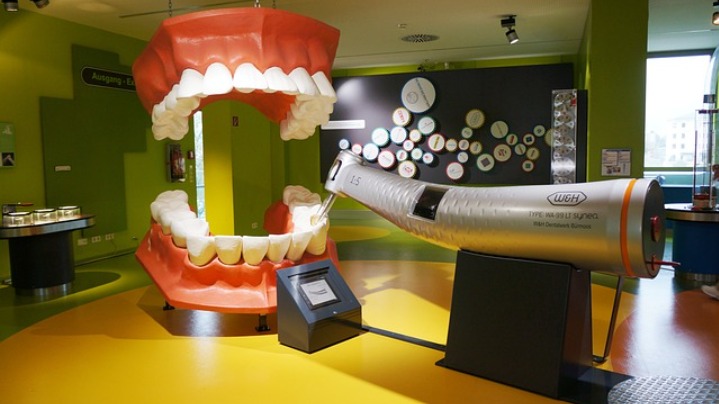
What are the Latest Advances in Dentistry?
Emerging and New Advancements in the Dental Industry
Contents
- Emerging and New Advancements in the Dental Industry
- Digital Dentistry
- Nano-Technology – Dental Nanomaterials
- Minimally Invasive Procedures Dentistry
- CAD/CAM Technology in Dentistry
- Biomaterials for Dental Applications
- 3D Printing – Dental 3D Printers
- Teledentistry
- Regenerative Dentistry
- Robotic Dentistry
- Clear Aligners
- Intraoral Scanners
- Cone Beam Computed Tomography (CBCT)
- Laser Dentistry
- Adhesive Dentistry
- Smart Dental Implants
- AI in Dentistry
- Final Word
Dentistry has seen a recent flurry of exciting advancements ensuring patients receive the best care possible. These advances include new techniques, methods for repairing teeth and gums, and technology that can help diagnose and treat oral diseases. Here are some of the most recent advances:
Digital Dentistry
The use of digital technology in dentistry has dramatically improved the accuracy and efficiency of various dental procedures, such as dental implants, orthodontic treatment, and cosmetic dentistry.
Digital dentistry is a growing field that allows dentists to provide their patients with dental care through digital means. This includes everything from providing patient information online to sending prescriptions and even performing surgery remotely. By using digital technology, dentists can provide their patients with the same quality of care they would receive in person but without the inconvenience of traveling to a dentist’s office.
ADA: Digital dentistry: What to know about a few popular technologies
Nano-Technology – Dental Nanomaterials
Nano-technology is increasingly used in dentistry, offering many potential patient benefits. For example, it allows for greater precision when treating tooth decay or injuries and improved biocompatibility.
Despite being one of the most common dental procedures, dental implants have been unchanged for over 50 years. This is mainly because traditional dental implants are made of metal, which can cause significant and potentially irreversible damage if it enters your body.
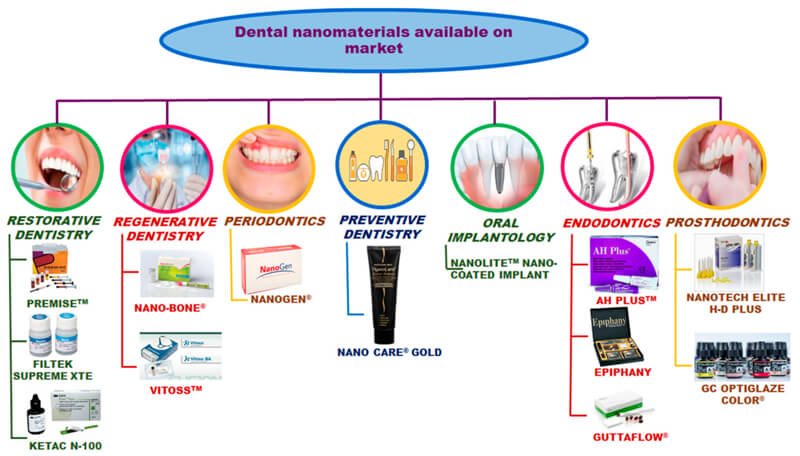
Recently, however, nanotechnology has emerged as a new solution to fixing teeth using implants. Nanotechnology is a field of technology that uses tiny particles smaller than 100 nanometers. Because these particles are so small, they can go straight through the body without causing any damage.
This means that dental implants made with nanotechnology can be much less likely to fail over time, and they also don’t require any additional surgery once they’ve been installed. Many people report that nanotechnology-based dental implants are as strong as metal ones.
PMC – NCBI: Nanotechnology and dentistry
Minimally Invasive Procedures Dentistry
Advances in materials and techniques have made it possible to perform many dental procedures with less damage to the tooth structure and surrounding tissues. This has led to faster healing times and improved outcomes for patients.
Some of the most common minimally invasive procedures include endodontics, periodontics, and orthodontics. Each has its benefits and drawbacks, so discussing your options with your dentist before deciding is essential.
Ericson: The Concept of Minimally Invasive Dentistry
CAD/CAM Technology in Dentistry
Computer-aided design and computer-aided manufacturing (CAD/CAM) technology have revolutionized the way dental restorations are created. With CAD/CAM, dental restorations can be designed and fabricated in a single appointment, reducing the time and cost of treatment.
CAD CAM technology is rapidly becoming the norm in dentistry – allowing dentists to create stunning images of their patient’s teeth, which can then be used for planning and treatment. Not only this, but it also allows Dentists to record their procedures to monitor and improve their work digitally. In addition, CAD-CAM technology has revolutionized the way dental implants are created, meaning that patients can now enjoy a lifetime of healthy smiles.
PubMed: The use of CAD/CAM in dentistry
Biomaterials for Dental Applications
New materials, such as bioceramics and biopolymers, are being developed for dentistry. These materials are biocompatible, durable, and able to mimic the natural tooth structure, making them ideal for dental restorations and implants.
Over the past few years, biomaterials dentistry has been on the rise in popularity. This is due to various reasons, but mainly because biomaterials offer many potential patient benefits. Here are just a few:
- Biomaterials can be custom-made to fit each individual’s tooth and jawbone perfectly.
- They are less likely to cause pain or inflammation than traditional dental materials and can last longer without needing replacement.
- They can improve dental hygiene by preventing plaque and bacteria from accumulating on the surface of teeth.
- They may also help restore teeth damaged or lost due to age or disease.
NYU College of Dentistry: Biomaterials
3D Printing – Dental 3D Printers
3D printing technology is being used in dentistry to create customized dental restorations, orthodontic appliances, and surgical guides, among other things. This technology has dramatically improved the accuracy and efficiency of many dental procedures
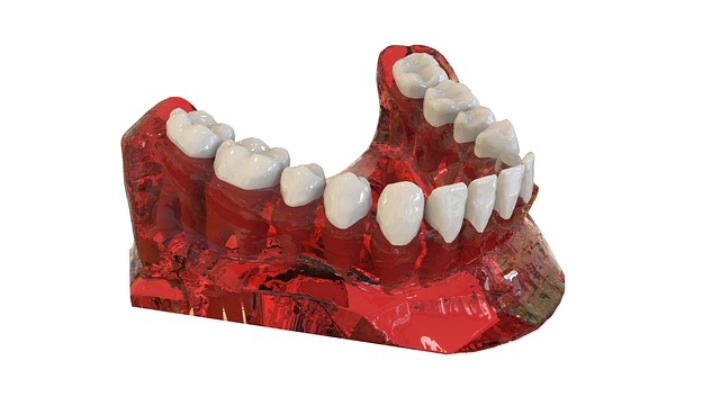
3D printing is revolutionizing dentistry, allowing for more accurate and patient-friendly treatments. Not only does it save time and money, but 3D printing also eliminates the need for traditional models and casts. Dentists can create custom dental implants, crowns, and other prosthetic devices using 3D printing technology.
British Dental Journal: 3D printing in dentistry
Teledentistry
The use of telecommunication and information technologies to provide dental care remotely has become increasingly popular in recent years. Teledentistry allows patients to receive dental consultations and treatment without visiting the dentist’s office in person, making dental care more accessible and convenient. It can be used to provide routine dental care, such as cleaning and oral examination, or it can be used for more complicated cases, such as dental surgery.
PMC: Applications of teledentistry: A literature review and update
Regenerative Dentistry
Advances in regenerative medicine and tissue engineering have opened up new avenues for regenerating damaged or lost tooth structures, such as pulp, dentin, and enamel. This can revolutionize how many dental conditions are treated, reducing the need for invasive procedures.
Regenerative dentistry is a relatively new field that focuses on restoring dentition using methods such as tooth extraction and implant placement, along with other forms of restoration such as crowns and veneers. It is believed that the use of regenerative dentistry can help to restore teeth to their natural state, increasing their lifespan and overall function.
Future Medicine: Advances in regenerative dentistry; building with biology
Robotic Dentistry
The development of robotic dental systems is allowing dentists to perform procedures with greater accuracy and precision. These systems are used for various procedures, including dental implant placement, crown preparation, and orthodontic treatment. The benefits of robotic dentistry are numerous.
- much faster than traditional dentistry
- less invasive, which means that fewer painkillers are required post-procedure
- can be used in difficult-to-reach areas or on teeth that are difficult to access with regular dental instruments.
- constantly improving, meaning that the quality of care provided by robots will only continue to improve.
PMC – NCBI: Dental Robotics: A Disruptive Technology
Clear Aligners
Clear aligners are a popular alternative to traditional metal braces. These custom-made, removable aligners are virtually invisible and allow patients to straighten their teeth without needing metal wires or brackets. Clear aligners are often used in conjunction with traditional braces but can also be used to correct minor misalignments. They’re easy to use and can be worn for months or even years, making them a perfect option for those who want permanent correction but don’t have the time or money for full braces.
Clear aligners are also less likely to cause pain than traditional braces, making them an ideal choice for children and adults who are uncomfortable wearing traditional braces.
Intraoral Scanners
Intraoral scanners are digital imaging devices that use light and cameras to capture high-resolution images of the mouth and teeth. These images diagnose dental problems and plan treatment, reducing the need for traditional dental impressions. In addition to providing a clear view of the teeth and gums, intraoral scanners can help locate dental implants and other dental appliances.
Cone Beam Computed Tomography (CBCT)
CBCT is a specialized type of dental X-ray that produces 3D images of the jaw, teeth, and surrounding structures. CBCT is used to diagnose and plan treatment for various dental conditions, including implant placement, endodontic treatment, and oral surgery.
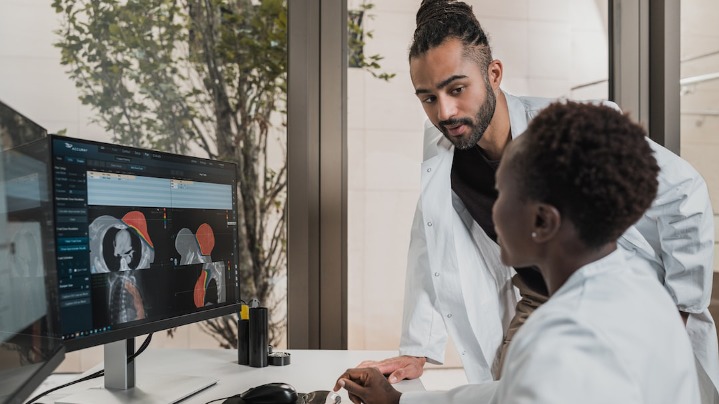
Cone Beam Computed Tomography (CBCT) dentistry is a new and innovative dental technology that uses X-rays to create detailed images of teeth. The technique is efficient and allows for more accurate diagnosis and treatment planning.
CBCT is fast, painless, and less expensive than traditional X-ray diagnosis or treatment. It is ideal for diagnosing dental problems such as cavities, missing teeth, lesions, and fractures. Additionally, CBCT can be used to plan direct treatment, such as fillings and root canals.
CBCT dentistry is highly effective and offers many benefits over traditional X-ray diagnosis or treatment. Patients should feel confident that they receive the most up-to-date information about their dental health.
FDA: Dental Cone-beam Computed Tomography
Laser Dentistry
The use of laser technology in dentistry is becoming increasingly popular. Lasers can be used for various procedures, including tooth whitening, gum disease treatment, and cavity detection. Lasers are known for their precision, reducing the need for invasive procedures and minimizing patient discomfort.
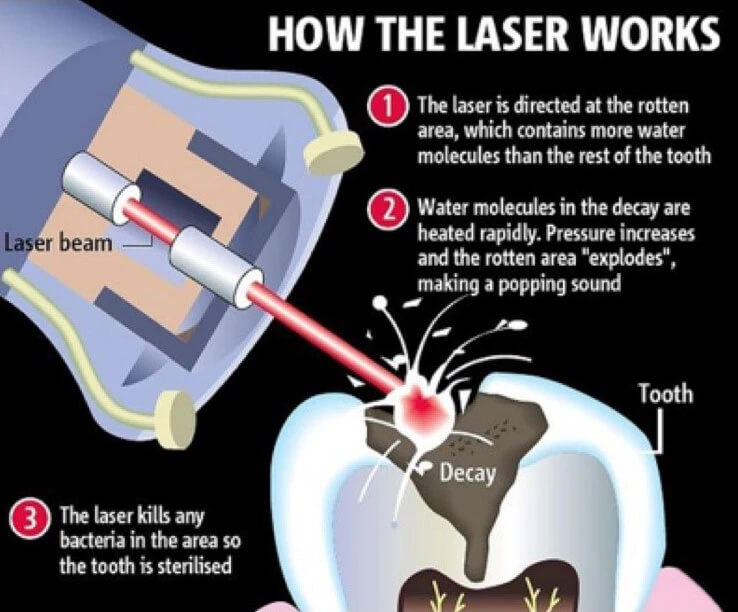
This painless process can be done in just a few minutes. The laser also helps to clean up any remaining dental areas. Laser dentistry has many benefits, including that it is less invasive than traditional dentistry procedures and results in less toothache and pain.
WebMD: Laser Use in Dentistry
Adhesive Dentistry
The development of advanced adhesives has made it possible to bond dental restorations directly to the tooth structure, reducing the need for invasive procedures and improving the longevity of dental restorations.
Adhesive dentistry is a new and growing form of dental care that uses adhesive to attach dental implants to the jawbone. This type of dentistry is often used to replace teeth that are missing or have failed due to decay or injury. Adhesive dentistry has many advantages over traditional dental implants, including a quicker and easier recovery after surgery.
Smart Dental Implants
Smart dental implants are a new type of implant that uses advanced technology to monitor and respond to changes in the oral environment. These implants are equipped with sensors that detect changes in temperature, pressure, and other parameters, providing real-time information to the dentist and helping to ensure the longevity and success of the implant.
ScienceDaily: Smart dental implants
AI in Dentistry
Artificial intelligence (AI) is used in dentistry to improve the accuracy and efficiency of various procedures. AI algorithms can analyze large amounts of data, such as patient records and images, to help dentists make more informed decisions and improve patient outcomes.
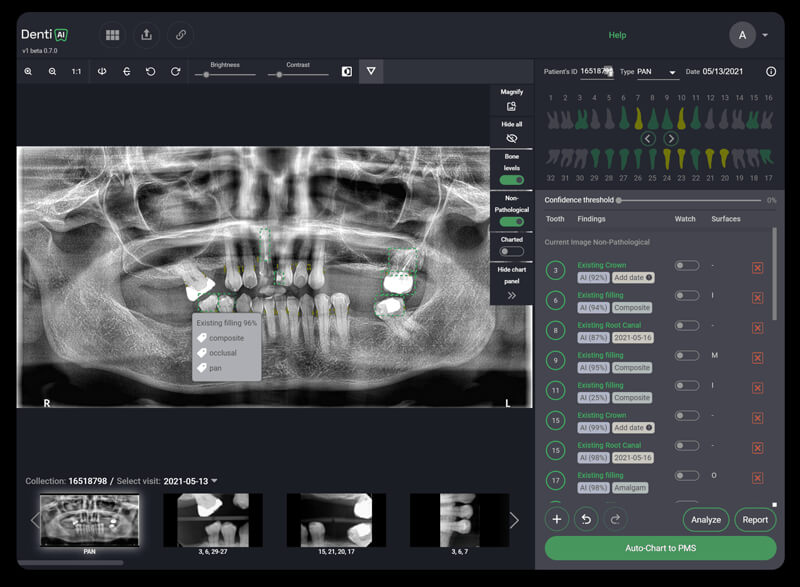
Dentists can use AI to quickly sift through large amounts of data to identify potential problems and decide on treatment options. This can save time and money by avoiding unnecessary dental trips and expensive diagnostic procedures. While some learning is still involved for dentists who want to use AI in their practice, its potential benefits are enormous.
Schwendicke: Artificial Intelligence in Dentistry: Chances and Challenges(PDF)
Final Word
These are just a few additional examples of exciting advancements in dentistry. The field is constantly evolving, and new technologies and treatments are being developed continuously, offering hope for better oral health for people worldwide.

